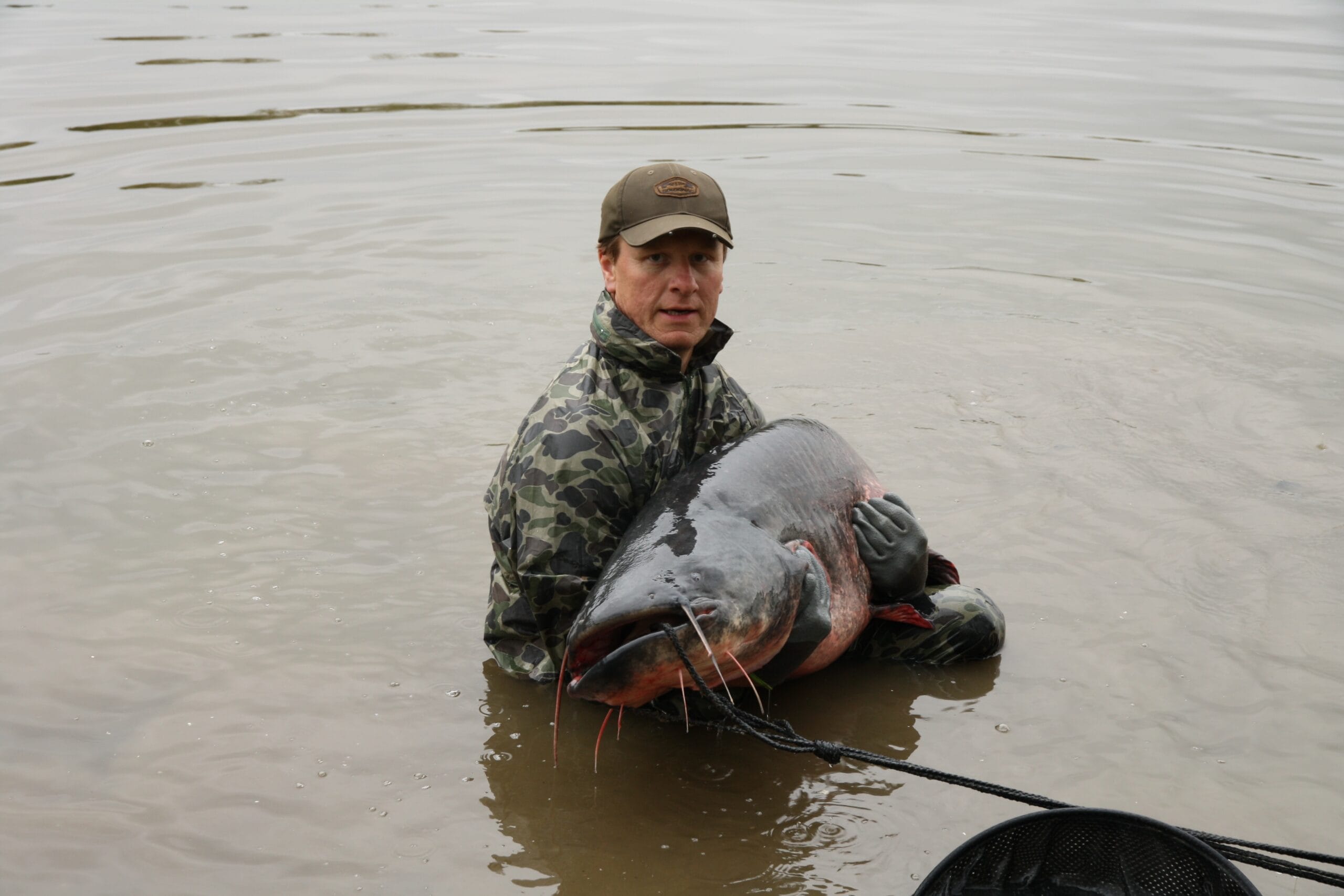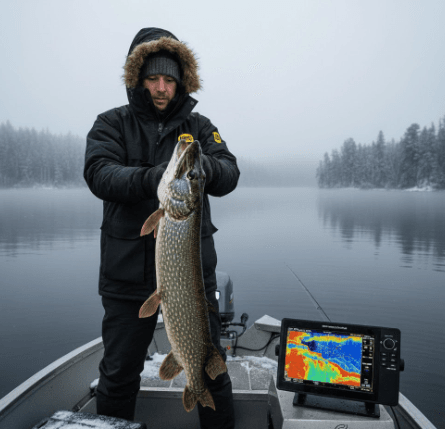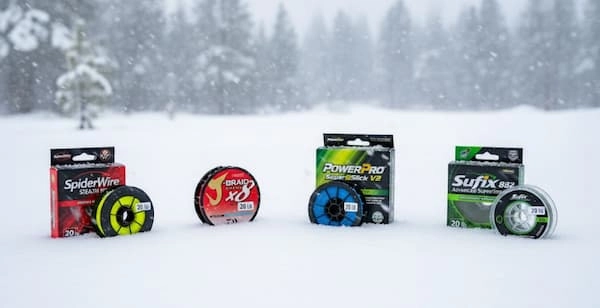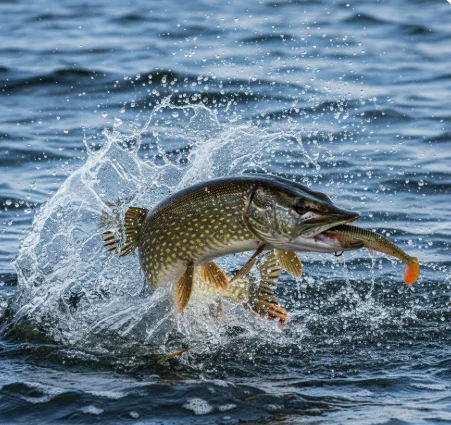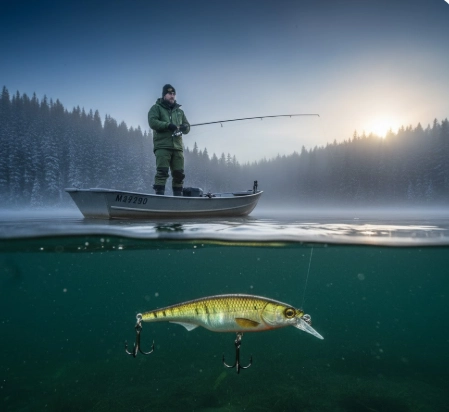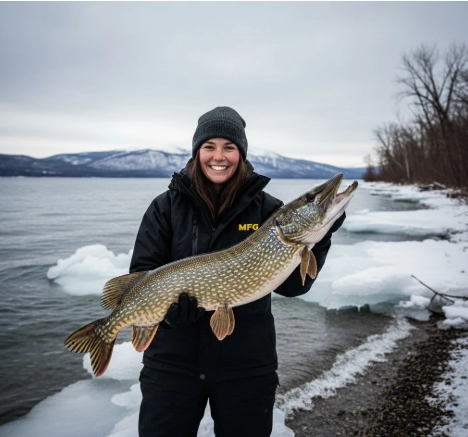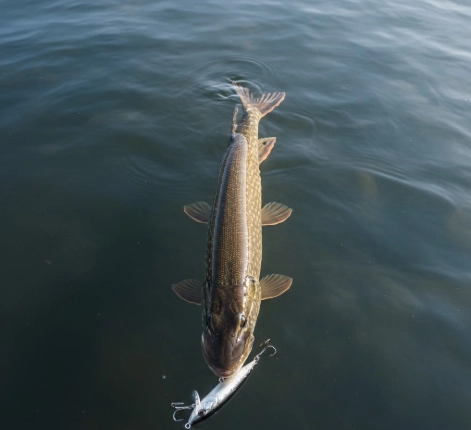“Best Catfish Fishing Guide 2025 – Baits, Rigs, Spots & Pro Tips for Monster Cats”
As an Amazon Associate, we earn from qualifying purchases — no cost to you. That’s how we keep this site running. Read more ›
Catfish are one of the most popular freshwater fish in the United States, and for good reason. They grow big, fight hard, taste great, and can be caught in rivers, lakes, and reservoirs all across the country. Whether you’re targeting channel catfish for a fun day on the water, going after blue catfish that can weigh over 100 pounds, or stalking a giant flathead catfish, the right knowledge and gear will make all the difference.
In this complete catfishing guide, you’ll learn everything you need to know to catch more and bigger catfish in 2025. From the best rods and reels to proven baits and rigs, plus expert tips on night fishing, trophy hunting, and the best times of year to target catfish – this guide covers it all. If you’ve ever wondered how to catch catfish like a pro, you’re in the right place.
Let’s dive in and break down the most effective strategies, setups, and gear that thousands of American anglers use every year to land monster catfish.
Types of Catfish – Channel, Blue, and Flathead Explained
When anglers talk about catfishing, they usually mean one of three species: channel catfish, blue catfish, or flathead catfish. Each one behaves differently, prefers different habitats, and requires slightly different tactics. Understanding the differences is the first step toward becoming a better catfish angler.
Channel Catfish
Channel cats are the most common and widely distributed catfish. They are found in rivers, lakes, and reservoirs almost everywhere. Known for their forked tails and spotted bodies (especially when young), channel catfish are aggressive feeders and will bite on a wide variety of baits, from worms and chicken liver to commercial stink baits. Most range from 1 to 10 pounds, but larger specimens can push past 20 pounds.
Blue Catfish
Blue catfish are the giants of the catfish world. They can easily exceed 50 pounds, and trophy blues of 80–100 pounds are caught every year. They have a bluish-gray body, a straight anal fin, and no spots. Blues thrive in big rivers like the Mississippi and the James, as well as large reservoirs. They prefer fresh cut bait like shad and herring, and are often targeted by serious anglers looking for monster fish.
Flathead Catfish
Flathead catfish are easy to recognize thanks to their broad, flat heads and mottled brown or yellow coloring. Unlike channel and blue cats, flatheads prefer live bait such as bluegill or sunfish. They are ambush predators that hide in log jams, deep holes, and undercut banks, waiting to strike. Flatheads regularly grow past 40 pounds, and some record fish weigh well over 100 pounds. Catching a big flathead requires heavy gear and a lot of patience.
Now that you know the differences between channel, blue, and flathead catfish, you can choose the right gear and bait for the species you’re targeting. Each one offers a unique challenge, which is why catfishing never gets old.
Best Catfish Rods and Reels – Complete Buyer’s Guide for 2025
When it comes to catfishing, your rod and reel setup is the single most important part of your gear. Catfish grow bigger than most freshwater species, pull harder, and often live in heavy current or snag-filled waters. Choosing the right rod and reel isn’t just about convenience – it’s about having the strength, durability, and performance to land the fish of a lifetime. In this section, we’ll break down exactly what makes a good catfish rod, what to look for in a reel, and finish with a proven rod and reel combo that many American anglers trust in 2025.
Catfish Rods – Length, Power, Action, and Materials
Rod length: The length of your rod determines casting distance, leverage, and how much control you have during the fight. For channel catfish in lakes and small rivers, rods in the 6’6” to 7’ range are ideal – compact, easy to handle, but still strong enough for fish up to 15 pounds. If you’re after flathead catfish, most serious anglers step up to rods in the 7’6” to 8’ range. These longer rods give you more leverage for pulling fish out of log jams and deep holes. For blue catfish, especially when fishing from the bank or in big rivers, rods in the 8–10 foot range are recommended. The extra length allows for longer casts and provides the backbone needed to control fish over 40 pounds.
Rod power: Power refers to how much weight the rod is designed to handle. Most catfish rods are medium-heavy, which covers the majority of fishing situations. Medium-heavy rods are versatile: they can handle smaller channel cats but are also strong enough for flatheads and medium-sized blues. For trophy fishing, a heavy power rod is the safer choice, capable of handling 30–80 lb test line and big baits without folding under pressure. Lighter rods (medium or below) may be fine for panfish or bass, but they are not built to handle the brute force of catfish.
Rod action: Catfish rods usually feature moderate to moderate-fast action. This means the rod bends deeper along its length, which is important for absorbing sudden runs and keeping steady pressure on the fish. Moderate action also works perfectly with circle hooks, which rely on steady pressure rather than a hard hookset. A fast-action rod might be great for bass fishing, but for catfish, you want a rod that bends and keeps the hook buried without tearing out.
Rod materials: The most common materials are fiberglass, graphite, and composite blends. Fiberglass rods are nearly indestructible, which is why many catfish anglers rely on them. They may feel heavier, but they rarely fail when a big fish makes a run. Graphite rods are lighter and more sensitive, but they can snap under extreme pressure – making them less reliable for trophy cats. Composite rods (a mix of fiberglass and graphite) combine the best of both worlds: toughness and sensitivity. For beginners and pros alike, fiberglass and composite rods are the go-to for serious catfishing.
Catfish Reels – Spinning, Baitcasting, and Conventional
Just like rods, reels come in different types, each with strengths and weaknesses. Choosing the right one depends on the size of fish you’re after and your level of experience.
Spinning reels: These are the most beginner-friendly reels and work well for small to medium catfish. For channel cats, reels in the 4000–5000 size range are ideal, holding plenty of 15–20 lb line with a smooth drag. If you’re targeting flatheads or medium blues, step up to a 6000–7000 size, which provides more line capacity and drag strength. Spinning reels are simple, affordable, and versatile – perfect for anglers who want a reliable all-around option.
Baitcasting reels: A favorite among more experienced anglers, baitcasters offer more cranking power and accuracy. They are excellent for heavy rigs, live bait, and pulling fish out of cover. For catfish, look for models that can hold at least 200 yards of 20–30 lb line and have a smooth drag system. Baitcasters require practice to avoid backlash, but once mastered, they deliver unmatched control and durability.
Conventional reels: These are built for trophy catfish. With massive line capacity (300+ yards of 30–50 lb line) and heavy drag systems (20–30 lb), conventional reels are designed for serious battles. They’re especially useful in big rivers with strong current, where you need brute strength to win. While overkill for small channel cats, conventional reels are the gold standard for blue catfish over 50 pounds and giant flatheads.
Recommended Catfish Rod and Reel Setup for 2025
After testing and thousands of reviews from American anglers, one setup stands out for versatility, durability, and availability. If you’re looking for a proven rod and reel that can handle almost any catfishing situation, consider pairing the Ugly Stik GX2 Spinning Rod (7’ Medium-Heavy) with the PENN Squall II Level Wind Conventional Reel. Together, they cover everything from 5 lb channel cats to monster flatheads and blues.
The Ugly Stik GX2 is nearly unbreakable, made with a fiberglass and graphite composite for strength and sensitivity. Its 7’ medium-heavy size is the perfect balance for catfishing: long enough for powerful casts and leverage, but compact enough for boat or bank fishing. Thousands of anglers have trusted the GX2 for decades, and it continues to be one of the most reliable rods for catfish in 2025.
The PENN Squall II Level Wind is one of the toughest reels in its class. With up to 33 lbs of smooth carbon drag, a marine-grade bronze gear system, and stainless steel pinion, it has the power and durability needed to land giant catfish. Its level wind system ensures even line lay, while the graphite frame keeps it strong yet lightweight. It’s the perfect partner for the GX2 rod, giving you a balanced, professional-grade setup trusted by trophy hunters across America.
Top 10 Catfish Baits That Always Work
No matter how strong your rod and reel setup is, you won’t catch catfish without the right bait. Catfish rely heavily on their sense of smell and taste, and the right bait can make the difference between a slow night and a bucket full of fish. Over the years, anglers have tested everything from live fish to homemade recipes, and some baits consistently outperform the rest. Here are the top 10 catfish baits that never fail, explained in detail so you know when and how to use each one.
1. Shad – The Classic Catfish Bait
Shad is the number one bait for blue catfish and a favorite across the United States. Fresh cut shad releases strong oils and blood that draw big cats from a distance. Use whole shad for large flatheads or cut pieces for blues. Frozen shad works in a pinch, but fresh is always better. If you’re fishing big rivers like the Mississippi, shad should be your first choice.
2. Bluegill and Sunfish – Perfect for Flatheads
Flathead catfish prefer live prey, and bluegill or sunfish are prime choices. Rig them on a circle hook and drop them near log jams or deep holes. The struggling motion of a live bluegill triggers the predator instinct in flatheads. Check local regulations before using gamefish as bait, but where it’s legal, this method is hard to beat.
3. Chicken Liver – Cheap and Effective
Few baits are as iconic as chicken liver. It’s messy, smelly, and irresistible to channel catfish. The downside is that it comes off the hook easily, so many anglers wrap it in mesh or thread it onto special liver hooks. It works best for smaller cats but can attract big ones on the right night. Always carry a container of livers for backup.
4. Stink Bait – The Commercial Favorite
Stink baits are specially made doughs, dips, or pastes designed to attract catfish. Brands like Dip Bait Tubes and Premo’s Super Sticky have loyal followings because they work. They are especially deadly for channel catfish, and they’re easy to use – just dip a treble hook or bait holder into the jar and cast it out. Stink baits shine in warm water when catfish are most active.
5. Nightcrawlers – The Universal Bait
Nightcrawlers are the ultimate all-around bait. They work for almost every species of catfish, especially channel cats. A big ball of worms on a hook creates a scent trail that catfish can’t resist. They are affordable, easy to find, and effective year-round. While they might not catch the biggest blue cats, they’re reliable for consistent action.
6. Cut Carp and Buffalo
In many regions, carp and buffalo are abundant rough fish, and their cut pieces make excellent bait. The oily flesh releases a strong scent, making them particularly attractive to big blue cats. Many trophy hunters swear by carp heads for giant catfish. It’s a great alternative when shad isn’t available.
7. Hot Dogs and Store-Bought Oddities
Believe it or not, hot dogs soaked in Kool-Aid or garlic powder can catch catfish. These DIY baits are especially fun for kids or casual anglers. While not as reliable as shad or bluegill, they can be surprisingly effective on stocked lakes and ponds. Catfish are opportunistic, and sometimes the strangest baits work.
8. Dip Worms and Sponge Hooks
Some stink baits are so soft they need a special holder. That’s where dip worms and sponge hooks come in. These are small rigs designed to hold messy paste bait underwater. They’re cheap, effective, and reusable, making them a great tool when fishing with commercial baits.
9. Homemade Catfish Baits
Many anglers have their own secret recipes – usually a mix of cheese, garlic, blood, and flour. Homemade baits can be incredibly effective, especially in local waters where catfish are used to natural food sources. The advantage is cost and customization, but the disadvantage is inconsistency compared to proven store-bought baits.
10. Shrimp – Store-Bought but Deadly
Frozen shrimp from the grocery store is a surprisingly effective catfish bait. It’s smelly, easy to rig, and often outperforms chicken liver. Some anglers soak shrimp in fish oil or garlic to make it even more appealing. Shrimp works well for both channel cats and smaller flatheads, especially in warmer months.
Each bait has its place, and the best catfish anglers carry a mix depending on conditions. Fresh cut bait like shad or carp is unbeatable for big blues, live fish rule for flatheads, and stink baits dominate for channel cats. Experiment and adjust based on the species and the season.
Of course, many anglers enjoy experimenting with their own homemade baits, and nothing beats the feeling of catching a catfish on a recipe you created yourself. But if you don’t have the time or don’t want to deal with the mess of mixing blood, cheese, and garlic in your garage, there are plenty of reliable store-bought options. Commercial baits have been tested for decades and continue to catch catfish across the country every single day.
One of the most effective choices is a ready-to-use stink bait. These baits are affordable, easy to store, and designed to spread powerful scent trails that catfish can’t resist. Instead of guessing whether your homemade batch will work, you can rely on proven formulas that anglers have trusted for years.
Best Catfish Rigs – Which Setup to Use and When
Even with the best rod, reel, and bait, you won’t catch catfish if your presentation is wrong. Catfish rigs are more than just lines and hooks – they control how your bait moves, how deep it sits, and how natural it looks. Different rigs shine in different conditions, and knowing which one to tie on can make or break your trip. Let’s break down the most effective rigs for catfish, explain how to tie them, and most importantly – when and why you should use each one.
Carolina Rig – Best All-Around for Bottom Fishing
The Carolina rig is one of the most versatile catfish rigs ever created. It consists of a sliding sinker above a swivel, a leader, and a circle hook. The sliding design allows catfish to take the bait without feeling much resistance, which is important because catfish often mouth the bait before swallowing it. This rig is perfect for channel and blue catfish feeding on the bottom.
When to use it: Calm to moderate current, fishing cut bait or chicken liver on the bottom. Great for lake bottoms, reservoirs, and slower river sections. Use lighter weights (1 oz) for ponds and heavier (3–4 oz) for rivers with stronger current. If you’re not sure what to start with, the Carolina rig should be your first choice.
Slip Sinker Rig – Simple and Reliable
The slip sinker rig is similar to the Carolina, but the leader is much shorter. That means the bait stays closer to the sinker, hugging the bottom. This is the classic setup you see beginners use because it’s easy, quick, and catches fish consistently. It shines with channel catfish and eater-size blues.
When to use it: Shallow lakes, small rivers, and ponds. Perfect for channel cats that feed right on the bottom. Use stink bait, worms, or cut bait. Not ideal for trophy cats because it doesn’t present big baits naturally, but if you’re fishing for a fish fry, this is the rig to use.
Santee Cooper Rig – The Blue Cat Killer
The Santee Cooper rig is a modified Carolina rig with a small float added to the leader just above the hook. This float lifts the bait a few inches off the bottom, preventing it from getting buried in mud or silt. That small change makes a huge difference when targeting blue catfish. They patrol just above the bottom and smash baits that stand out in the current. Anglers on the Mississippi, James, and Ohio Rivers swear by this rig for monster blues.
When to use it: Strong current rivers and deep reservoirs. Perfect for cut shad, herring, or carp chunks. Best when fish are actively feeding and you want to present bait in a more visible, natural way. If you’re trophy hunting for 40–60+ lb blues, this is your go-to rig.
Float Rig – Perfect for Flathead Catfish
Flathead catfish are ambush predators and prefer live bait. The float rig lets you suspend a live bluegill, shad, or sunfish at the exact depth you want, just above cover. This keeps the bait alive and moving naturally, which is exactly what triggers a flathead strike. By adjusting the float stopper, you can fine-tune your presentation for different depths.
When to use it: Rivers with log jams, fallen trees, or deep holes. Use live bait like bluegill or sunfish. Ideal at night when flatheads come out to hunt. This rig is not about numbers – it’s about quality. If you want your personal best flathead, a float rig with live bait is your best chance.
Three-Way Rig – Heavy Current and Deep Water
The three-way rig is built for extreme situations: big rivers, deep holes, and ripping current. A three-way swivel lets you attach your main line, leader, and a drop line with a sinker. The drop line is usually lighter so if it gets snagged, only the sinker is lost. This rig keeps your bait anchored but still moves naturally just off the bottom. Trophy hunters targeting giant blue catfish in heavy current use this rig because it can hold big live or cut bait right in the strike zone.
When to use it: Big rivers like the Mississippi or Missouri with strong flow. Ideal for large cut bait or live bait. Use heavy sinkers (4–8 oz) to keep the bait down. If you’re fishing the toughest conditions and want a shot at record-class fish, the three-way rig is the one.
How to Choose the Right Rig
Here’s a quick breakdown to make your decision easier:
- Carolina Rig: Best all-around choice for beginners. Use when unsure, with cut bait or stink bait on the bottom.
- Slip Sinker Rig: Use in ponds, lakes, or small rivers for eater-size channel cats.
- Santee Cooper Rig: Use in big rivers and reservoirs with strong current when targeting trophy blue catfish.
- Float Rig: Best for flatheads with live bait near cover, especially at night.
- Three-Way Rig: Use in extreme current and deep water for giant blues and flatheads.
Each rig has its own strengths. The secret is not to pick one and use it everywhere, but to adapt your rig to the conditions. That’s what separates casual anglers from those who consistently land trophy catfish.
If you’re new to catfishing or just want to save time, you can grab a catfish rig kit. These kits come with everything – hooks, swivels, sinkers, beads, and floats – so you can tie any of the rigs above without hunting for parts. It’s the easiest way to get started and makes sure you always have the right rig ready.
Best Time of Year and Day to Catch Catfish
Knowing when catfish feed most actively is just as important as knowing what bait or rig to use. Catfish behavior changes dramatically with the seasons, water temperature, and even the time of day. If you want to consistently catch more and bigger fish, you need to plan your trips around the times when catfish are most aggressive. Let’s break it down by season, time of day, and weather so you can maximize every outing.
Spring – Spawn and Shallow Feeding
Spring is one of the best times of year for catfishing. As water warms into the 60s, catfish move into shallow water to feed heavily before spawning. Channel catfish are especially active in coves, creek mouths, and along riprap banks. Blue catfish start chasing shad schools aggressively. Flatheads begin feeding more consistently at night as water temps climb. In late spring, catfish spawn in cavities, under logs, and in rocky banks – during this period they may feed less, but the weeks leading up to it can be incredible.
Best time of day: Afternoon and early evening when water is warmest. Focus on shallow flats, rocky banks, and creek mouths where baitfish are active.
Summer – Night Fishing for Giants
Summer heat drives catfish deeper during the day, but once the sun sets, the action explodes. Flathead catfish become highly active after dark, roaming shallows in search of live baitfish. Channel cats move along shorelines, especially near weed beds and docks. Blue cats often hold deeper in main channels, but they’ll come up on ledges and flats to feed at night. Summer is also prime time for stink baits and dip baits, since warmer water helps scent spread quickly.
Best time of day: Night fishing is king in summer. From sunset to midnight is peak activity, with another strong window just before dawn. A headlamp and glow stick rod tips are essential gear for summer catfish trips.
Fall – Feeding Frenzy Before Winter
Fall is arguably the best time of year for trophy catfish. As temperatures drop, catfish sense winter approaching and feed aggressively to bulk up. Blue catfish in particular go on a binge, hammering fresh cut bait like shad and carp. Flatheads also feed heavily before slowing down in cold water. Channels can be caught in large numbers as they group up. This is the season when records are broken.
Best time of day: Daytime and evening both produce well in fall. Catfish are less sensitive to light and more focused on feeding. Fish river bends, deep ledges, and channel drops where baitfish school up.
Winter – Deep Water Blues
Winter fishing can be tough, but it’s also when the biggest blue catfish are caught. As water temperatures drop into the 40s, most catfish move into deep holes, channels, and slow-moving sections of rivers. Blues stay active in cold water, but flatheads and channels slow down significantly. The key is fishing deep and slow with fresh cut bait. Electronics help find wintering holes where big cats stack up.
Best time of day: Midday when the sun slightly warms the water. Focus on deep holes, dams, and channel edges. Dress warm and be patient – winter bites are fewer but often bigger.
Weather, Moon, and Rising Water
Aside from season and time of day, catfish are highly influenced by weather and moon phases. A rising river after a rainstorm can trigger aggressive feeding as fresh food washes into the system. Cloudy days extend feeding periods, while bright sun often pushes fish deeper. At night, a new moon is generally better than a full moon, since darkness makes catfish less cautious. If you see a storm front approaching, grab your rods – feeding windows often open just before pressure changes.
Final Thoughts – Fish Smart, Not Hard
| Season | Best Time of Day | Catfish Behavior | Best Baits |
|---|---|---|---|
| Spring | Afternoon & Evening | Feeding in shallows, pre-spawn | Shad, worms, chicken liver |
| Summer | Night & Early Morning | Flatheads hunt live bait, channels near shore | Live bluegill, stink baits |
| Fall | Day & Evening | Feeding frenzy before winter | Cut shad, carp chunks |
| Winter | Midday | Blues in deep holes, channels slow | Fresh cut bait |
Catching catfish consistently is all about timing. Spring brings shallow feeding, summer requires night fishing, fall triggers a feeding frenzy, and winter rewards patient anglers with giants. Combine that seasonal knowledge with the right rigs and baits, and you’ll always be in the game. If you plan your trips based on these seasonal patterns, you’ll catch more fish with less effort – and increase your odds of landing the trophy catfish you’ve been dreaming about.
Where to Find Catfish – Rivers, Lakes, and Ponds
One of the biggest mistakes beginner anglers make is thinking catfish are spread evenly across a lake or river. The truth is, catfish are structure-oriented, seasonal, and highly influenced by current and food sources. If you know where to look, you can cut your search time in half and dramatically increase your success. Let’s break down the best locations in rivers, lakes, and ponds, plus a quick calendar of seasonal hotspots across the year.
Finding Catfish in Rivers
Rivers are catfish highways. Current delivers food, and catfish position themselves where they can ambush an easy meal without burning energy. The key spots in rivers include:
- Deep Holes: Catfish gather in scour holes and channel bends, especially during the day.
- Outside Bends: Stronger current sweeps bait along the outside of bends, making them prime feeding spots.
- Log Jams & Structure: Flatheads in particular love heavy cover like timber and root wads.
- Tailwaters Below Dams: Blues and channels feed heavily in turbulent water where baitfish get disoriented.
Finding Catfish in Lakes
Lakes don’t have current to concentrate fish, so structure becomes even more important. Look for:
- Drop-Offs and Ledges: Catfish cruise along depth changes, especially at night.
- Creek Channels: Old river channels in reservoirs act like highways for catfish.
- Riprap and Rock Banks: Rocks attract baitfish, which attract catfish.
- Points and Flats: Shallow feeding zones in spring and fall, deeper edges in summer and winter.
Finding Catfish in Ponds and Small Lakes
In ponds and small lakes, catfish don’t have as many options, so you need to think simple. The best areas include:
- Inflow Areas: Where creeks or drains bring fresh water and food.
- Weed Edges: Catfish patrol weed lines for small fish and insects.
- Structure: Any fallen tree, dock, or brush pile will hold fish.
- Deeper Pockets: In summer, ponds get hot – catfish retreat to the deepest spots available.
Day vs. Night Catfish Locations
Catfish change position between day and night. During the day, they often hold deeper – in holes, channels, or shade. At night, they move shallow to hunt. This is why many anglers fish deep holes at midday, then move to shallow flats, riprap, and shorelines after dark. Matching your location to the time of day is just as important as choosing the right bait.
Seasonal Catfish Location Calendar
| Season | Where to Look | Best Species |
|---|---|---|
| Spring | Shallow flats, coves, creek mouths | Channel Catfish |
| Summer | Deep holes (day), shallow banks (night) | Flathead Catfish |
| Fall | Channel drops, ledges, points | Blue Catfish |
| Winter | Deep river holes, dams, slow channels | Blue Catfish |
Map Tip – How to Use Modern Tools
Modern anglers don’t just guess where fish are – they use tools. Google Maps, Navionics charts, and fish finder apps show drop-offs, river bends, and deep holes before you even hit the water. Combining seasonal patterns with mapping tools lets you plan smarter trips. Even in small ponds, satellite images can show inflow creeks, shade lines, and potential hotspots. Don’t just fish blind – use maps like a pro.
Final Thoughts – Location is Everything
You can have the right rod, reel, bait, and rig – but if you’re not fishing where the catfish actually live, you won’t catch anything. Rivers, lakes, and ponds all hold catfish, but their positioning changes by season, time of day, and structure. Study maps, watch the water, and match your location to the conditions. That’s the real secret to turning time on the bank into fish on the line.
Catfish Tactics and Techniques – Proven Methods That Work
Knowing the best gear, bait, and rigs is important, but it’s your fishing tactics that truly decide whether you catch a few fish or fill a cooler. Catfish can be targeted in many ways, from sitting on the bank with a rod in a holder to running a line of jugs across a lake. Each method has its strengths, and the best anglers mix and match depending on conditions. Let’s look at the most effective catfishing tactics and when to use them.
Bank Fishing – Simple but Effective
Bank fishing is the most common way people catch catfish. All you need is a rod, reel, bait, and a good spot. During the day, set up near deep holes, river bends, or shaded banks. At night, move shallow where catfish come to feed. A solid rod holder is essential because catfish hits can be sudden and violent. Multiple rods spread along the bank let you cover more water. Bank fishing is perfect for beginners, but even pros know that some of the biggest flatheads are caught sitting on a log with one rod propped up in the mud.
Boat Fishing – Precision and Mobility
Fishing from a boat opens up a whole new level of precision. You can position directly over deep holes, anchor near structure, or drift across flats. Boats let you cover more ground and find where catfish are concentrated. Many trophy hunters prefer boat fishing because it allows them to target specific ledges, channels, and underwater structure that bank anglers simply can’t reach. The ability to move and adapt quickly is a huge advantage, especially when targeting blue catfish in large reservoirs.
Drift Fishing – Covering Big Water
Drift fishing is one of the most effective ways to catch big blue catfish in lakes and rivers. Instead of anchoring, you let the wind or current move the boat slowly while dragging baits along the bottom. The key is to use drifting rigs with sinker slides or Santee Cooper setups that keep the bait just off the floor. Drift fishing covers massive areas, helping you locate active fish quickly. It works best in reservoirs with big flats or in rivers with steady current. If you’re after numbers and size, drifting is hard to beat.
Jugging – Fun and Highly Productive
Jugging is an old-school method that still works amazingly well. Plastic jugs, pool noodles, or foam floats are rigged with line, hook, and bait, then released to drift across the lake. When a catfish bites, the jug starts bouncing and moving. Jugging is not only productive but also fun, especially for families or groups. It’s best for catching numbers of channel and blue catfish in lakes. Regulations vary, so always check local laws before setting out a spread of jugs.
Trotlines and Limb Lines – Traditional and Effective
Trotlines and limb lines are traditional methods used for centuries. A trotline is a long main line stretched across a river or cove, with baited hooks attached at intervals. Limb lines are tied to overhanging branches or fixed objects with one or two hooks. Both methods are effective at catching multiple fish overnight. Flathead hunters especially like limb lines baited with live bluegill. Trotlines can load a cooler with channel cats. These methods require more setup and checking but remain among the most efficient ways to harvest catfish.
Cast Netting for Bait – The First Step
No matter which tactic you use, fresh bait often makes the biggest difference. That’s why many serious catfish anglers throw a cast net before fishing to catch live shad, bluegill, or other baitfish. Learning to throw a cast net takes practice, but it saves money and gives you the freshest bait possible. For flatheads and blues, nothing outperforms live or freshly caught baitfish, and a net makes sure you always have them on hand.
Final Thoughts – Match Tactics to Your Goals
There’s no single “best” way to catch catfish – it all depends on your goals. If you want a relaxing evening, bank fishing with rod holders is perfect. If you’re after trophies, drift fishing from a boat is hard to beat. Families looking for fast action love jugging. Old-school trotlines and limb lines are unbeatable for filling coolers. The best anglers know how to adapt, switching between tactics depending on the season, water, and species. Try different methods, and you’ll quickly see what works best for you.
Catfish Gear Checklist – Don’t Hit the Water Without These Essentials
When it comes to catfishing, success isn’t just about having the right bait or knowing the best spot. You need the proper gear to land big fish and handle them safely. Forgetting one piece of equipment can ruin a trip, so having a checklist keeps you prepared. Here’s a complete breakdown of the must-have catfish gear that every angler should carry before heading out.
Rods and Reels
We covered rods and reels earlier in detail, but they deserve a place on this list. For channel catfish, a medium-heavy rod paired with a 4000–5000 size spinning reel is perfect. For blues and flatheads, step up to heavy rods and 6000–8000 reels with strong drags. Always carry at least two setups – one lighter for eater-size fish and one heavy-duty for trophies. Don’t risk being under-gunned when a monster bites.
Hooks
Hooks are the heart of your setup. Circle hooks (sizes 4/0–8/0) are the gold standard for catfish – they hook fish in the corner of the mouth and reduce gut hooks. Kahle hooks are a hybrid option, offering wider gaps for bigger baits. Treble hooks are commonly used with stink baits and dip worms for channel cats. Make sure you stock a variety, because one size does not fit all. If you only carry circle hooks, you’re covered for 90% of situations.
Line and Leaders
Catfish are strong and fight hard, so your line must match. For channel cats, 15–20 lb monofilament works well. For blue and flathead catfish, step up to 30–50 lb braid for strength and sensitivity. Always use a leader – abrasion-resistant mono or fluorocarbon in the 30–60 lb range. Leaders protect against sharp rocks, snags, and catfish spines. Don’t cheap out on line; it’s the only connection between you and the fish.
Weights and Sinkers
To keep your bait where it needs to be, you’ll need a selection of sinkers. Egg sinkers are perfect for slip rigs. No-roll sinkers stay put in heavy current. Bank sinkers work well on three-way rigs. Carry multiple sizes (1–8 oz) so you can adjust based on current and depth. Nothing is more frustrating than being underweighted in strong flow or overwaited in still water.
Tools
Tools make catfishing safer and easier. Always carry:
- Pliers: For removing hooks safely.
- Fish Grips: To handle catfish without getting finned.
- Scissors or Line Cutters: For cutting braid and leaders.
- Gloves: Protect your hands when landing big fish.
Nets and Landing Gear
A good landing net is essential, especially for big blues and flatheads. Choose one with a deep, knotless bag to prevent tangles. Fish grips are also great for lifting smaller fish from the bank or boat. Don’t try to hand-land a 40 lb blue cat – it usually ends badly for your hands. Proper landing gear saves fish and saves you from injuries.
Lights and Night Gear
Since so much catfishing happens at night, lighting is crucial. A strong headlamp keeps your hands free. Glow stick rod tip lights help you see bites in the dark. Lanterns or LED floodlights can light up your fishing area. Don’t underestimate the importance of good lighting – it can make night fishing safer and far more enjoyable.
Storage and Coolers
Catfishing often means long hours, so you need proper storage. A bait bucket keeps live bait fresh. A sturdy cooler stores drinks, food, and the day’s catch. Tackle boxes keep your hooks, sinkers, and tools organized. Organization saves time – less fumbling means more fishing.
Pack Smart, Fish Smart
Catfishing doesn’t have to be complicated, but it does require preparation. Having the right gear ensures you’re ready for anything – whether that’s a two-pound channel cat for the fryer or a fifty-pound blue that will test every knot in your setup. Use this checklist to pack smart, stay safe, and fish with confidence. The more prepared you are, the more successful your trips will be.
Catfish Safety and Handling Tips – Stay Safe While Landing Giants
Catching catfish is exciting, but handling them requires care. Catfish are powerful, slippery, and armed with sharp spines on their pectoral and dorsal fins. Many beginners don’t realize how dangerous those spines can be until they get stuck – and trust me, it’s painful. Proper handling keeps you safe and ensures the fish survives if you’re releasing it. Here’s everything you need to know about staying safe while landing catfish of all sizes.
Watch Out for the Spines
Every catfish has three sharp spines – one on the dorsal fin and one on each pectoral fin. These spines are coated in mucus and can cause painful wounds if they puncture the skin. For small channel cats, grip the fish firmly behind the pectoral fins with your hand spread wide, making sure the spines point outward and away from your palm. For larger catfish, avoid “lipping” them like bass – their crushing jaws and rasp-like teeth can tear up your hand. Instead, use tools like fish grips or nets.
Use Gloves and Grippers
Gloves and fish grippers are a lifesaver. A sturdy pair of fish-handling gloves gives you better grip and protects against cuts from teeth and fins. Fish grippers clamp onto the fish’s lower jaw, letting you control it without risking your hands. This is especially useful for big blues and flatheads, which can thrash violently once landed. Always wet your gloves before grabbing a fish if you plan to release it – this protects the fish’s slime coat and reduces stress.
Handling Big Catfish
Landing a 5-pound channel cat is one thing, but a 50-pound blue cat is another story. Large catfish require extra caution. Never try to swing a big catfish into the boat or onto the bank with your rod – that’s a quick way to break gear or lose the fish. Instead, guide the fish into a large landing net or secure it with a fish gripper. When lifting a big catfish for a photo, support its weight with both hands – one hand gripping the jaw (with a gripper or glove), the other hand under the belly. This prevents injury to both the fish and yourself.
Removing Hooks Safely
Catfish often inhale baits, and their thick, bony mouths can make hook removal tricky. Always carry long-nose pliers or a hook remover tool. For deep-hooked fish, a disgorger tool helps pop the hook free without damaging the fish. Avoid sticking your fingers in the fish’s mouth – even smaller cats have abrasive pads of teeth that can cut skin. Circle hooks usually make this easier since they set in the corner of the mouth, allowing for quick and safe removal.
Catch and Release Best Practices
If you plan to release a catfish, proper handling is critical. Keep the fish in the water as much as possible, and avoid dragging it across rocks or dry ground. Support its body when lifting for photos. If the fish seems exhausted, hold it gently in the water facing into the current until it swims away strongly. Never throw a catfish back – that causes serious injury. Respect the fish and the resource, and you’ll help ensure catfish populations remain strong for the future.
First Aid for Catfish Stings
If you do get finned by a catfish spine, wash the wound immediately with soap and water. Some anglers swear by immersing the wound in hot water to reduce pain and neutralize toxins in the mucus. Always disinfect and cover the wound, and seek medical attention if swelling or infection develops. Prevention is best, but knowing how to respond keeps you safe if accidents happen.
Respect the Fish, Protect Yourself
Catfishing is a blast, but these fish demand respect. Their spines, size, and strength make them both exciting and risky to handle. Using gloves, fish grippers, and proper landing techniques keeps you safe and makes catch-and-release more successful. Whether you’re chasing eater-size channels or giant blues, handling them the right way ensures you enjoy the fight without a trip to the emergency room.
Cleaning and Cooking Catfish – From Water to Table
Catching a catfish is only half the reward – the other half is enjoying it at the dinner table. Catfish are among the best-tasting freshwater fish, with mild, sweet flesh that works in dozens of recipes. But to enjoy them at their best, you need to clean them properly. Done right, you’ll have clean fillets with no mud taste and no waste. Let’s walk through the steps to clean, fillet, and cook catfish like a pro.
Preparing to Clean Catfish
First, gather your tools. You’ll need a sturdy fillet knife, cutting board, pliers (for skinning smaller fish), and clean water for rinsing. Many anglers also use an electric fillet knife to speed things up, especially when cleaning multiple fish. Always keep safety in mind – sharp knives and slippery fish don’t mix well, so take your time and work carefully.
Skinning Whole Catfish
For smaller channel cats (under 5 lbs), many anglers still use the classic skinning method. Start by cutting just behind the head down to the backbone. Use pliers to grab the skin near the head and peel it back toward the tail in one piece. Once skinned, cut along the belly and remove the guts. This old-school method works well for frying whole catfish, especially when you want crispy skin-on fillets or nuggets.
Filleting Catfish
For larger catfish, filleting is the best option. Lay the fish flat on your cutting board. Make a cut just behind the gills down to the backbone, then turn the knife and run it along the spine toward the tail, keeping the blade tight to the bones. Once the fillet is free, flip it skin-side down and remove the skin by sliding the knife between flesh and skin while holding the tail. Trim away the dark bloodline and fatty belly meat – this is what gives catfish an occasional “muddy” flavor. Rinse fillets in cold water and pat them dry before cooking.
Cleaning Tips for the Best Taste
The key to great-tasting catfish is removing all traces of blood and fat. Always cut out the red bloodline that runs along the center of the fillet. Remove any yellow fat near the belly. Smaller fish (2–5 lbs) generally taste better than larger ones, which can develop stronger flavors. If your fillets smell muddy, soak them in milk or buttermilk for an hour before cooking – it neutralizes any off-flavors and tenderizes the meat.
Cooking Catfish – Classic Recipes
Catfish can be cooked in many ways, but a few classics stand out:
- Southern Fried Catfish: Coat fillets in seasoned cornmeal, then fry until golden brown. Serve with hush puppies and coleslaw.
- Cajun Blackened Catfish: Rub fillets with Cajun spices and sear in a hot cast-iron skillet.
- Baked Catfish: Place fillets in a baking dish, season with lemon, garlic, and herbs, then bake until flaky.
- Catfish Nuggets: Cut smaller fillets into chunks, bread, and fry – a favorite for kids.
Final Thoughts – From River to Plate
Catfish are one of the few freshwater fish that offer both a thrilling fight and a delicious meal. Cleaning them properly ensures your fillets are fresh, mild, and free of off-flavors. Cooking them with classic methods like frying, baking, or blackening turns your hard work into a reward worth every cast. Whether you keep a few for the table or release the big trophies, learning to clean and cook catfish completes the full fishing experience.
Catfish FAQ – Quick Answers for Common Questions
What is the best bait for catfish?
Fresh cut bait like shad, herring, or skipjack is the top choice for blue catfish. Flatheads prefer live bait such as bluegill or sunfish. Channel cats love stink baits, chicken liver, and worms. The best bait depends on the species you’re targeting.
What size hook should I use for catfish?
For channel cats, sizes 2/0–4/0 circle hooks work well. For blue and flathead catfish, step up to 6/0–10/0 circle hooks. The hook should match the size of your bait, not just the fish.
What is the best time of day to catch catfish?
At night during summer, catfish feed aggressively in shallow water. In spring and fall, afternoons and evenings are best. In winter, midday is most productive since the sun slightly warms the water.
Do catfish bite better before or after rain?
Catfish often feed aggressively right before and during a rainstorm, especially when rising water washes in food. After heavy rains, focus on creek mouths and inflows where fresh water enters.
How deep should I fish for catfish?
It depends on the season. In spring and fall, catfish move shallow (2–10 feet). In summer days and winter, they stay deep (15–40+ feet). Adjust based on water temperature and time of day.
Can you catch catfish in the winter?
Yes. Blue catfish remain active in cold water and are often caught in deep river holes and reservoirs. Channel and flathead catfish slow down but can still be caught with patience and fresh bait.
Are circle hooks better for catfish?
Yes. Circle hooks reduce gut-hooking and almost always set in the corner of the mouth. They’re more effective for catch and release and improve hookup ratios compared to J-hooks.
What pound test line is best for catfish?
For eater-size channel cats, 15–20 lb mono is enough. For trophy blues and flatheads, 30–50 lb braid with a heavy leader is recommended. Always adjust based on the size of fish in your waters.
Do catfish eat live bait or dead bait?
Flatheads almost always prefer live bait. Blue cats thrive on fresh cut bait. Channel cats will take either, but stink baits and prepared baits are especially effective. Matching the bait to the species is key.
How big do catfish get in the US?
Channel catfish typically reach 10–20 lbs, though the record is 58 lbs. Blue catfish can exceed 100 lbs, with the world record at 143 lbs. Flatheads also surpass 100 lbs, with records over 120 lbs.
What rigs work best for catfish?
The Carolina rig is the most versatile all-around catfish rig. For trophy blues, the Santee Cooper rig shines. For flatheads, float rigs with live bait are unbeatable. Slip sinker rigs are great for channels in lakes and ponds.
Do catfish bite during the day?
Yes. Catfish bite all day, but their behavior changes. In bright conditions, they stay deeper. Early morning, late evening, and overcast days increase shallow activity. Night is best in summer.
Mastering Catfish Fishing
Catfishing is more than just a hobby – it’s a tradition, a challenge, and for many, a way of life. From understanding the best rods and reels, choosing the right bait, and learning proven rigs, all the way to cleaning and cooking your catch, this guide has covered everything you need to succeed. Whether you’re chasing eater-size channels or monster blues, preparation, patience, and persistence will always pay off. Now grab your gear, hit the water, and put these tips into action.


